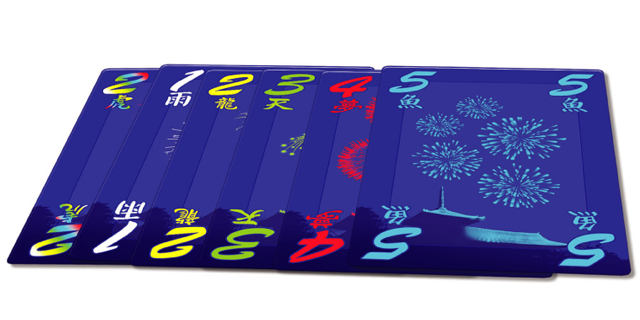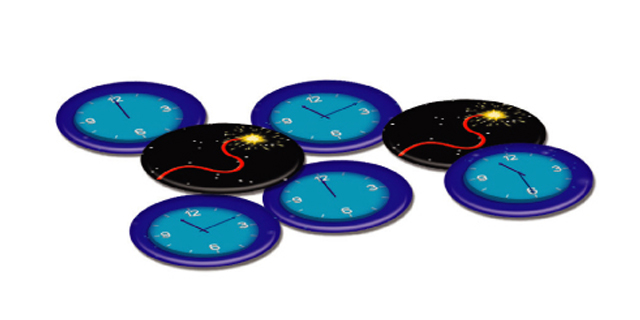
Most cooperative games pit the players against a sort of cardboard AI, forcing them to bail water against a relentless rising tide until they either achieve victory or drown in the attempt. Antoine Bauza’s Hanabi, however, is a rare specimen, in that there is no simulated opponent or opposing force; the players are simply trying to recreate fireworks displays that had become jumbled through some comic mishap prior to play starting.
Well… maybe “simply” was the wrong word to use.
Each player (up to five) has a hand of cards, each depicting one stage of a colored suit, numbered from one through five. In the standard version of the game there are five such suits, and each suit has the same distribution: three ones, one five, and two of everything else. Players are challenged with playing these cards in sequence in order to produce the most magnificent fireworks display. The catch? Players can see others’ hands, but not their own. Indeed, properly drawing new cards to your hand is the first skill Hanabi players must master, as it goes against every instinct you have gained to this point.

Once that hurdle is cleared, players must choose one of three actions on each turn. The first and most common is to give another player a clue. A clue consists of indicating one or more cards in that player’s hand and informing them of either the suit or the numerical value shared by those cards. You must include all such cards in a player’s hand when doing this. Armed with that knowledge, a player may then use an action to either play or discard a card from their hand, then drawing a replacement. Discarding a card will regenerate a clue, of which there is a limit of eight. Playing a card that is legal — either a one of an unplayed suit or the next stage of a suit already in progress — will score a point, and playing the five on a suit will also regenerate a clue. Playing an illegal card will result in the players losing a fuse (strike), and three strikes will end the game with zero points earned. Through careless discards or illegal plays, it is possible for some cards to become impossible to play, which will result in fewer than the maximum 25 points being scored.
At first the prospect seems daunting, but Hanabi rewards logic above all else. Give the right clues, and your partners should be able to piece the rest together, although it might take several plays before everyone gets a handle on what needs to be told and what needs to be ignored. The next level beyond those basics is determining which player needs to be told what. At first, it’s obvious enough that you are most directly responsible for making sure the player on your left doesn’t do anything foolish. Suppose, then, that you decide to give a clue to the next player in the turn order. What can the player on your left then infer about their own hand, assuming you are giving the best possible clue at that moment and based on what, if anything, they already know about it?

Among more competitive gamers, certain conventions concerning (for example) which cards are in danger of being discarded will be established prior to play in order to better manipulate information, but you shouldn’t need this in order to do well. All you need to do is to take stock of all the information available to you, and realize that this doesn’t just mean what you can see in your partners’ hands. Cards that have been played and discarded are also public knowledge. If a white four has already been tossed, it’s worth remembering that there is now only one more in the deck, making it just as valuable as the equally-rare five… which of course needs the four to be played so it doesn’t become a dead draw!
If you find the base game to not provide enough challenge, there are three variants included in the rules, all of which involve a sixth “rainbow” suit. The first simply adds the suit as a fully-stocked sixth color, bringing the maximum score to 30 points. A harder variant adds only one of each stage of the sixth suit, making each one of them precious! The final variant makes these “rainbow” cards wilds for the purposes of giving color clues, but still count as their own suit for the purposes of legal plays. Only the hardest of the hardcore should attempt this one! Another version that should probably not be attempted is a two-player game. Although the rules natively support this, such a session loses a lot of the experience of the game.
Hanabi’s elegant design and addictive gameplay has earned a lot of attention since it was first published in 2010, including winning the prestigious 2012 Spiel des Jahres. As such, it has been hard to get a hold of this hot commodity, but now that it is becoming widely available in the U.S. you should be able to find it for about $10. With no in-game text it can be an interesting experience with younger players. The manufacturer suggests ages eight and up, although the command of logic required might exceed the grasp of your average second-grader so a slightly older starting age is recommended by most players. That said, a good Hanabi group is something that needs to be cultivated, regardless of the ages of those involved.



















